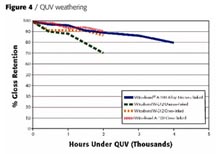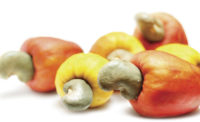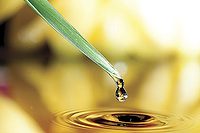Solvent-Free and M-Pyrol-Free PUDs



In this article we review the pros and cons of eliminating cosolvents or switching to other organic solvents. Synthetic routes to minimize NMP usage are cited from the literature. Commercially available NMP-free and cosolvent-free aqueous Witcobond® PUD grades are discussed. Examples of a wide range of solid content and average-particle-size PUDs are given. The physical properties of these grades can be hard and mar resistant, strong and tough or soft and pliable. The applications of these solvent-free PUDs in textiles, coatings and adhesives are briefly reviewed. Examples of starting formulations are also given.

Discussion
One important side benefit of removing M-Pyrol is the improvement in color stability. As mentioned earlier, M-Pyrol residue in the dried film tends to cause yellowing, particularly at high temperatures. A good illustration of color improvement is the recent development of Crompton's Witcobond W-290HSC in our laboratories. A film from this M-Pyrol-free product was cast on white Carrara glass and subjected to 140°C for 20 hours in a convection oven. Very slight discoloration was observed. By comparison, a film from a product containing only 2.5% M-Pyrol showed significant yellowing (Figure 2).
The other option is to make the PUDs without any cosolvent. This option is the most preferred but is also the most challenging.





Applications
In addition to the general coating and adhesives for various substrates mentioned above, these grades are particularly suited for applications listed in Table 5. In Table 6 are some suggested grades for the various textile applications. It is noteworthy that most of these grades have excellent color stability at relatively high temperatures. This color fastness allows for curing at relatively high temperatures without having to worry about yellowing.
Another application area where these grades are used to an advantage is in printing inks. The inks derived from blends of Witcobond A-100 and Witcobond W-290H not only have good printability, excellent resistance to rubbing, and easy clean-up but also provide excellent viscosity versus shear as shown in Figure 5. The overprint varnish provides for higher-gloss, mar rub and better chemical resistance.

In leather coating, the advantages are not only the low-VOC and high-solid content but also good coalescence at room temperature. This forms a film of high tensile with high elongation that provides a tough coating with a good feel, low-temperature flexibility, and is crosslinkable with good interlayer adhesion.

Conclusions
California Proposition 65 makes the presence of M-Pyrol in the finished product undesirable due to the requirement of special labeling for potential toxicity. The elimination of M-Pyrol changes the manufacturing, formulation and application of waterborne polyurethane dispersions. Crompton's patented technology utilizes reactive acrylate diluents in manufacturing of M-Pyrol free, low-VOC Witcobond PUDs. The finished urethane/acrylate alloy has excellent properties for many applications.
A wide array of M-Pyrol-free and 100% polyurethane/ polyureas are also commercially available from Crompton's Witcobond polyurethane dispersions. Superior yellowing resistance and other properties make them suitable for demanding applications in coatings, inks and adhesives.
References
1 MSDS for 1- methyl -2- pyrrolidone, BASF Corporation, 1995.2 Dieterich, D. and Reiff, H. Adv. Urethane Science & Technology vol 4,112 (1976).
3 Kobylanska, I.; Konkus, D. M.; and Ley, D. A. Adhesives Age, April 2001.
4 Loewrigkeit, P.; Van Dyke, K. A. U.S. Patent 4,644,030; 1987.
(Witcobond is a registered trademark of Crompton Corporation and/or its subsidiaries. M-Pyrol is a registered trademark of ISP Management, Inc.)
This paper was presented at the PIC Conference, October 1, 2003, Los Angeles, CA.
For samples and literature, contact 877/873.0273 (U.S.) or 732/826.5901(outside U.S.). For technical inquiries, contact 914/784.4954, or bechaib@cromptoncorp.com.
Looking for a reprint of this article?
From high-res PDFs to custom plaques, order your copy today!






